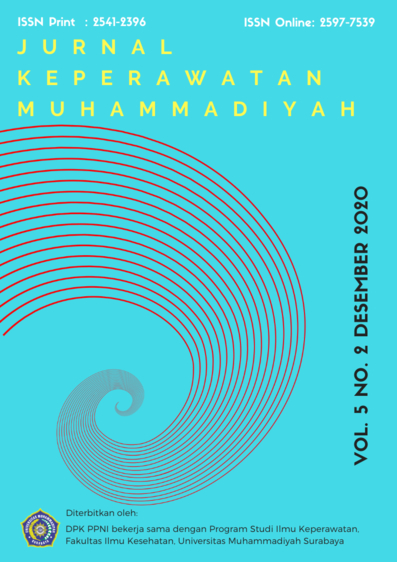Pengaruh Aplikasi Akupuntur Pada Pasien Hipertensi di Puskesmas Sentani Kabupaten Jayapura
DOI:
https://doi.org/10.30651/jkm.v5i2.6608Keywords:
Aplikasi Akupuntur, Akupuntur, HipertensiAbstract
Hypertension is blood pressure that exceeds normal limits divided into three categories. Hypertension is dubbed as a silent killer with symptoms of feelings of bending, headaches, palpitations, blurred vision, ringing in the ears, fatigue, vertigo, and nosebleeds. In addition, trends in treatment using alternative and complementary therapies are starting to appeal to the community, one of which is acupuncture. Acupuncture is a method of treatment by attaching needles to certain points on the body to reduce blood pressure or relieve symptoms of hypertension. This study aims to determine the application of acupuncture at points: LV3, HT7, PC6, and LU9 in hypertensive patients. This research was an experimental pretest-posttest without a control group with a time series approach, in 15 people with blood pressure criteria ≥130mmHg. This research was conducted from November 2018 to February 2019 using the analysis of the repeated ANOVA test. The results of the comparative output mean it is known that average hypertension before the acupuncture application was 172.93 mmHg, and after the acupuncture application 155.87 mmHg at the first meeting, hypertension before the acupuncture application was 154.50 mmHg and after the acupuncture application was 135.73 mmHg at the second meeting with the results of the in-action effect test revealed a Greenhouse-Geisser sig value of 0,000, so it can be concluded that there is a difference in the decrease in average blood pressure in hypertensive patients. Efforts that can be done are monitoring the continuity of hypertensive patients in carrying out acupuncture therapy.References
AHA (American Heart Association). (2017). 2017 Guideline for the Prevention, Detection, Evaluation and Management of High Blood Pressure in Adults. https://healthmetrics.heart.org/wp-content/uploads/2017/11/Detailed-Summary.pdf.
Ardelia, P. (2018). Modul Belajar Terapi Komplementer Akupuntur Umum. Banyumas: Pusat Pendidikan dan Pelatihan Akupuntur dan Herbal Indonesia.
BKTM (Balai Kesehatan Tradisional Masyarakat). (2012). Gambaran Penurunan Tekanan Darah Penderita Hipertensi dengan Penanganan Akupuntur Di Kota Makassar. Makassar: BKTM.
Chen, H., Shen, F. E., Tan, X. D., Jiang, W. B., & Gu, Y. H. (2018). Efficacy and safety of acupuncture for essential hypertension: a meta-analysis. Medical science monitor: international medical journal of experimental and clinical research, 24, 2946.
Darmawan, A., Berawi, K. N., Karimah, N., & Wahyudo, R. (2019). Efektifitas terapi akupunktur terhadap penderita hipertensi. Jurnal Agromedicine, 6(2).
Depkes, R. I. (2013). Mencegah dan mengontrol hipertensi agar terhindar dari kerusakan organ jantung, otak dan ginjal. Depkes RI, 2015.
Hariyanto, S. (2020). Pengaruh terapi akupunktur terhadap penurunan tekanan darah pada lansia dengan hipertensi di Panti Werdha Mojopahit Mojokerto. Jurnal Keperawatan, 9(1), 1-7.
Hasnah, H., & Ekawati, D. (2017). Pengaruh Terapi Akupunktur Pada Pasien Hipertensi Di Balai Kesehatan Tradisional Masyarakat Makassar. Journal of Islamic Nursing, 1(1), 41-46.
Indrati, N. G., Garnis, N., & Siti Soekiswati, M. H. (2018). Pengaruh Pemberian Akupunktur Titik Baihui Dan Titik Hegu Pada Lansia Penderita Hipertensi. (Disertasi doctoral tidak dipublikasi). Universitas Muhammadiyah Surakarta. Diakses dari: https://core.ac.uk/download/pdf/154927257.pdf.
Khasanah, U. N., Imandiri, A., & Adianti, M. (2018). Hypertension Therapy Using Acupuncture and Herbals of Leds and Carrots. Journal of Vocational Health Studies, 2(2), 67-73.
Li, J., Wang, Y., He, K., Peng, C., Wu, P., Li, C., & Lai, X. (2018). Effect of acupuncture at LR3 on cerebral glucose metabolism in a rat model of hypertension: a 18F-FDG-PET study. Evidence-Based Complementary and Alternative Medicine, 2018.
Plachta, D. T., Gierthmuehlen, M., Cota, O., Espinosa, N., Boeser, F., Herrera, T. C., Stieglitz, T., & Zentner, J. (2014). Blood pressure control with selective vagal nerve stimulation and minimal side effects. Journal of neural engineering, 11(3), 036011. https://doi.org/10.1088/1741-2560/11/3/036011.
Saputra, O., & Fitria, T. (2016). Khasiat Daun Seledri (Apium graveolens) Terhadap Tekanan Darah Tinggi Pada Pasien Hiperkolestrolemia. Jurnal Majority, 5(2), 120-125.
Sari, I. P. (2015). Faktor-faktor yang berhubungan dengan terjadinya stroke berulang pada penderita pasca stroke (Doctoral dissertation, Universitas Muhammadiyah Surakarta).
Tan, X., Pan, Y., Su, W., Gong, S., Zhu, H., Chen, H., & Lu, S. (2019). Acupuncture therapy for essential hypertension: a network meta-analysis. Annals of translational medicine, 7(12).
Turnbull, F., & Patel, A. (2007). Acupuncture for blood pressure lowering: needling the truth. Circulation, 115(24), 3048–3049. https://doi.org/10.1161/CIRCULATIONAHA.107.706952.
Yang, J., Chen, J., Yang, M., Yu, S., Ying, L., Liu, G. J., & Liang, F. R. (2018). Acupuncture for hypertension. Cochrane Database of Systematic Reviews, (11).
Yumni, F. L., & Holidah, E. N. (2018). Masase kaki dengan citronella oil terhadap penurunan tekanan darah pasien hipertensi di wilayah Puskesmas Medokan Ayu Surabaya. Jurnal Keperawatan Muhammadiyah, 3(1).
Zhao, H., Li, D., Li, Y., Yang, Y., Liu, Y., Li, J., & Mao, J. (2019). Efficacy and safety of acupuncture for hypertension: an overview of systematic reviews. Complementary therapies in clinical practice, 34, 185-194.
Zheng, H., Li, J., Li, Y., Zhao, L., Wu, X., Chen, J., … & Cui, J. (2019). Acupuncture for patients with mild hypertension: A randomized controlled trial. The Journal of Clinical Hypertension, 21(3), 412-420.
Downloads
Published
Issue
Section
License
- Penulis tetap memegang hak atas karyanya dan memberikan hak publikasi pertama kepada jurnal ini yang secara simultan karya tersebut dilisensikan di bawah:Â Creative Commons Attribution-ShareAlike 4.0 International (CC BY-SA 4.0)













